
The beautiful thing about camouflage is that once you see the pattern, you can guess what sort of environment it was evolved to exist in. In a new paper published in the journal Current Biology, a team of paleontologists did just that, working backward from preserved feather pigments to understand the world of a dinosaur that once roamed what is today China.
Based on that analysis, they argue that the dinosaur, which was called Sinosauropteryx and lived about 130 million years ago, spent its days in an environment that was much less forested than scientists previously believed it to have been.
"I'm convinced by the evidence of dark and light feathers in these exceptional fossils," Mike Benton, a paleontologist at the University of Bristol in the U.K. not involved with the study, wrote Newsweek in an email.
That conclusion is based on a principle called counter-shading, a type of camouflage strategy. Sunlight always comes from above, so a three-dimensional object of one color looks brighter on top and darker on the bottom, where it's in the shadows. When something is counter-shaded, it compensates for this with a darker top and lighter bottom. Then, when sunlight hits it from above, it appears to be all more or less the same color, which makes it look both less three-dimensional and less like a tasty snack.
But light patterns are different in large open spaces versus in shady places like forests—and counter-shading tends to be a little bit different to match, with a starker contrast straight across an animal's midline being more effective camouflage in open area.
So the team behind the new paper looked at three different fossils from Sinosauropteryx to put together a detailed picture of its coloring. They spotted the coloring pattern characteristic of more open, sunny environments.

They also identified a dark mask-like pattern around the dinosaur's eyes, like that of a modern raccoon. And while the suburban bandits are the most well-known example, plenty of other critters show similar markings, which scientists think may protect their eyes from bright sunlight reflecting off their hair or feathers. The pattern may also make it harder for hungry predators to identify their eyes, making it another form of camouflage.
The same authors have used a similar approach on Psittacosaurus and Borealopelta markmitchelli to recreate their camouflage techniques.
Sinosauropteryx would have needed all the camouflage it could get, since its neighbors included tyrannosaurs related to the infamous T. rex.
Uncommon Knowledge
Newsweek is committed to challenging conventional wisdom and finding connections in the search for common ground.
Newsweek is committed to challenging conventional wisdom and finding connections in the search for common ground.
About the writer
Meghan Bartels is a science journalist based in New York City who covers the science happening on the surface of ... Read more
To read how Newsweek uses AI as a newsroom tool, Click here.








